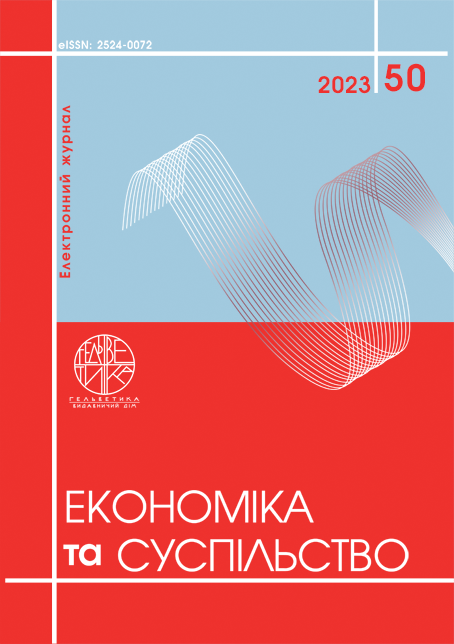SEARCHING FOR WAYS TO IMPROVE THE FORCED DISTANCE LEARNING OF STUDENTS
Abstract
First, the coronavirus pandemic, and then the war caused the search for ways to organize the educational process. Education is undoubtedly important for any country in the world, so it is necessary to organise the educational process at a high quality level under any conditions. Thanks to information technologies, it has become possible to study at a distance online. However, educators had to face a number of difficulties when implementing the educational process in a distance format. The purpose of this study is to analyze the problem of organizing distance learning in the conditions of the pandemic and russian aggression and to identify ways to improve forced distance learning in Ukraine. The main research methods that were used in writing the article are statistical, graphic, analysis and synthesis. Distance learning has become a challenge not only for students but also for teachers. There are problems in the process of working remotely during quarantine: technical competence of teachers and students; registration and communication procedures, meaningful structuring of information flow; remote schedule and workload optimisation; multitasking; personal space as a learning environment; electronic dean's office. In the article, the authors analyzed statistical data on the number of education seekers and educational institutions in which classes were held in various formats: distance, face-to-face, and mixed. Four teaching models are explored in the article: correspondence, tele-education, multimedia, virtual. Authors distinguish certain types of learning: traditional learning, synchronous learning, blended learning, and revel the essence of them. Authors analyzed platforms such as Moodle, Google Classroom, which can be used for study and communication, or an educational institution can use its own developed learning platform, such as MIX SumDU at Sumy State University. Analyzing the essence of distance education and e-learning, authors conclude that the idea is not new, as its elements are implemented in educational process. The development of distance education in Ukraine continues and it is enhanced by the development of the Internet and the improvement of distance learning methods.
References
Kulish N.M. (2022). The specifics of using the form of forced distance learning in medical higher educational institutions. Pedagogy of creative personality formation in higher and secondary schools. P. 209–212. Available at:: http://www.pedagogy-journal.kpu.zp.ua/archive/2022/81/39.pdf (access date: 04/20/2023). (In Ukrainian)
Kotenko S.I. (2023). Modern methods of online learning and their use in educational institutions of Ukraine. ". Collection of materials of the International Scientific and Practical Conference for Educators (Chernihiv, March 22, 2023). Chernihiv: NGO "Scientific and Educational Innovation Center for Social Transformations". 48-49. Available at: https://doi.org/10.54929/conf_ped_03_2023 (accessed on 31.03.2022). (In Ukrainian)
Shcherbachenko V.O., Hnilokozova P.O. (2023). Searching for ways to improve forced distance learning of schoolchildren and students. March scientific discourse 2023 on the topic: "Determinants of strengthening the role of education in the post-war reconstruction of Ukraine." Collection of materials of the International scientific and practical conference for educators (Chernihiv, March 22, 2023). Chernihiv: NGO "Scientific and Educational Innovation Center of Social Transformations". P.46-47. (In Ukrainian)
Hnatyuk O.V. Distance learning: problems, searches, challenges. Kyiv. URL: https://lib.iitta.gov.ua/728350/1/%D0%A2%D0%B5%D0%BA%D1%81%D1%82.pdf (accessed on 20.04.2023). (In Ukrainian)
Sergeeva T. (2020).Distance learning as a challenge of time: experience of e-learning during the Covid-19 pandemic. Methodology of education. P. 90–97. Available at: https://journals.indexcopernicus.com/api/file/viewByFileId/1297010.pdf (accessed on 20.04.2023). (In Ukrainian)
Oleshko A. A., Rovnyagin O. V., Godz V. R. (2021). Improvement of distance learning in higher education in conditions of pandemic restrictions. Public administration: improvement and development. 1. Available at: http://www.dy.nayka.com.ua/?op=1&z=1936 DOI: https://doi.org/10.32702/2307-2156-2021.1.3 (accessed on 18.04.2023). (In Ukrainian)
Regulations on the distance form of obtaining a complete general secondary education: approved by the order of the Ministry of Education and Culture of September 8, 2020. №1115. URL: https://zakon.rada.gov.ua/laws/show/z0703-13#Text (accessed on 20.04.2023).
State Statistics Service. Demographic and social statistics / Education. URL: https://ukrstat.gov.ua/operativ/operativ2022/osv/osv_rik/arch_pto_u.htm (accessed on 20.04.2023).
The number of students who study full-time and mixed is growing every time – Serhii Shkarlet. Ministry of Education and Science of Ukraine. URL: https://mon.gov.ua/ua/news/kilkist-uchniv-yaki-navchayutsya-ochno-ta-zmishano-shorazu-zrostaye-sergij-shkarlet (accessed on 20.04.2023).

This work is licensed under a Creative Commons Attribution 4.0 International License.


